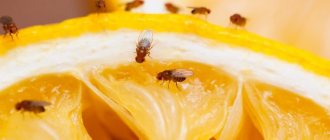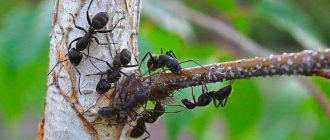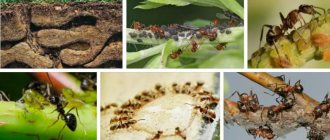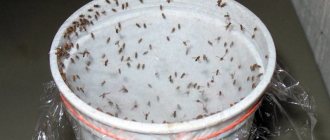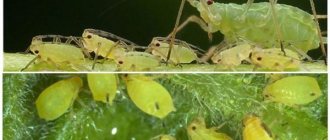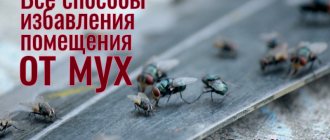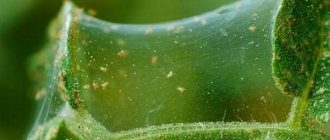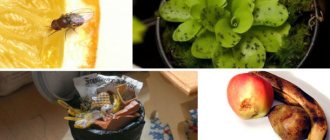Gardeners prefer to grow seedlings themselves. Sometimes white and black midges appear on it. Insects attack tomatoes, eggplants, cucumbers, and cabbage. The larvae destroy the root system and the seedlings will not bear fruit. Therefore, you need to get rid of pests immediately.
Types of midges
Sciarids, black soil mosquitoes, are found on seedlings. Whiteflies appear less frequently and attack leaves and stems. Adults drink the juice of the plant and weaken them.
Drosophila flies live on indoor flowers, rotting fruits and vegetables. They are small, dark brown, and multiply quickly. Green lacewings destroy aphids and do not harm plants.
Black midges appear due to waterlogging of the soil. This is typical for cold window sills with no air circulation. These two combinations create ideal conditions for the laying of eggs from which the larvae hatch. It is they, and not adult insects, that cause the most damage to seedlings.
It is not always clear how the pests got started. They can be brought along with purchased soil. This becomes clear only when the midges have time to reproduce. Therefore, any land must undergo disinfection.
Midges appear after heavy use of organic fertilizers. This creates a breeding ground for hatching larvae - warm and humid. Sometimes seedlings get bugs from indoor plants that are already infected.
Insects can be found in the ground, on stems or leaves. They remain invisible for a long time. Therefore, they are discovered only after the midges have seriously multiplied and their numbers have reached frightening proportions.
Prerequisites for the occurrence of whiteflies
The whitefly requires only 3 conditions for life and reproduction: warmth, humidity and lack of ventilation. With these 3 indicators, she feels very comfortable.
An additional suitable condition is the excessive density of planted plants, which gives it the opportunity to migrate to new places of food.
In greenhouses it damages tomatoes, cucumbers, peppers, and eggplants. In open garden beds, strawberries, potatoes, melons and fruit-bearing trees suffer from its invasion.
Indoor plants in closed, poorly ventilated rooms with high humidity become victims of this moth, tireless in its own gluttony, very quickly. Impatiens, orchids, fuchsias, begonias, and geraniums die before they have time to amuse the owner with their blooms.
Preparatory activities
If bugs or flies appear in the seedlings, it is necessary to get rid of them urgently. Any delay threatens that there will be even more of them. It is necessary to use ready-made chemicals to kill pests and folk remedies.
It is necessary to dry the soil and remove excess moisture. To do this, the pots are placed in the sun and not watered for several days.
The room needs to be thoroughly cleaned, the floor, trash can, and window sills should be washed. All organic residues are removed from surfaces.
If the pots with seedlings are equipped with a tray for collecting water, it must be emptied and dried in a timely manner.
Between waterings, you need to loosen the soil - this will improve drying and provide air access to the root system.
Use toothpicks to loosen small pots, and forks for larger ones.
Moderately dry soil allows:
- prevent rotting of the roots;
- prevent egg laying;
- deprive the larvae of food, as they feed on rotten roots.
In order to determine the degree of infection, you need to carefully remove the seedling from the pot and clean off the earthen lump. Afterwards the roots are inspected. If they are not covered with balls of worms, everything is not so scary.
You need to start fighting midges as soon as they are discovered. Do not allow adults to reproduce further.
Why is whitefly dangerous?
Both adult individuals and whitefly larvae can be easily compared to massive pumps - they are so voracious. Boogers suck the juices from the leaves and shoots of plants, rapidly undermining their health. The pest’s favorite delicacy is delicate tissues (The structure of tissues of living organisms is studied by the science of histology)
tomato seedlings. But he does not disdain other crops: seedlings of cucumbers, zucchini, peppers, eggplants, flowers, etc.
A secretive lifestyle gives the enemy a head start. Insects manage to breed in countless numbers and cause severe harm to the seedlings. The presence of a pest can be found indirectly:
- seedlings are lagging behind in development and look depressed;
- seedling shoots become brittle;
- leaves become covered with pale yellow spots, curl and dry out;
- A sticky coating appears on the shoots and leaves.
Sticky secretions, which insects often leave on the inside of leaf blades, add even more problems, as they become a suitable environment for the proliferation of spores of fungal diseases. In addition, the seedling moth is a carrier of dangerous viral infections of plants, which cannot be cured.
Features of the use of insecticides
It is necessary to fight insects on the leaves and larvae in the ground. For this it is better to use special chemicals. Insecticides are potent drugs. Safety precautions must be followed.
Types of funds:
- Aerosols. Sprayed in the habitats of flies, scare away and destroy them. Destroy cockroaches, ticks, flies.
- Solutions. Designed for spraying and watering the soil.
- Powders. They are laid in the ground and destroy the larvae.
Each group has its pros and cons.
Before using any drug, you must carefully study the instructions. Follow the dosage. You should not add more product, otherwise it will lead to the death of the seedlings.
The treatment is carried out in a non-residential area. You can go out onto the balcony or into the courtyard. A man puts on protective clothing, gloves, and a face mask. Animals, children, and other adults are removed from the room.
For treatment, it is better to use several products that are aimed at the soil and the plant itself. First the soil is processed, then the stems and leaves.
Repeated treatment is carried out after a week. The room is washed, ventilated, and hard-to-reach places are cleaned especially well.
Of the cheap and effective insecticides, Dichlorvos is often chosen. It is caustic and can burn plants. For processing you need to take a plastic bag. The product is carefully sprayed inside it. After which the bag is fixed over the seedling. It should not touch the leaves. Therefore, it is secured with a support in the ground or with the help of external objects.
The “greenhouse” is left for 10 hours, after which it is removed. This method effectively gets rid of larvae and adults.
How to look for signs of infection
Constant inspection of plants will quickly identify the presence of a pest and begin active fight against it.
- At any touch, a cloud of small, snow-white midges rises from the plant.
- On the underside of the leaves there is a sticky substance - honeydew and translucent scales - larvae.
- There are black, rotten spots of fungus on the leaves.
- The leaf curls and begins to die.
- The development of the plant is inhibited and it fades.
- The pest can cause the development of chlorosis and leaf curl.
For infected plants in the garden and greenhouse, you need to start comprehensive treatment using chemical and traditional means. Indoor infected flowers are sent to a separate room for quarantine and treatment.
New product on the market - fumigators
There are innovative products that are produced in the form of plates. It is enough to insert them into a special device that will heat the surface and cause it to release chemicals into the air.
The insecticide included in the composition has a detrimental effect on most insects. It is harmless to children and animals. The plate needs to be changed every 12 hours.
There is a more economical option - a bottle of liquid. It can be left in the fumigator for several days.
Before purchasing, read the instructions for use. Each product has its own affected area - from 20 sq.m to 50 sq.m. Popular products are “Raptor” and “Transflutrin”.
Available Methods
If it is not possible to purchase proven chemicals, you can use improvised materials. You will need a box of matches. Their heads stick into the soil. 5-6 pieces are enough for one pot.
Afterwards the soil is lightly watered. The sulfur will come off the base and disinfect the soil. Every person can cultivate the soil. The matches are changed daily until the insects disappear completely.
If you have midges in your house, you can try the “Zvezdochka” balm. The product contains only natural ingredients. It has a strong eucalyptus smell, which insects don't like. Therefore, it is enough to apply it in a thin layer on the rims of the pots.
If black midges fly over pepper seedlings, then you should buy tea tree essential oil at the pharmacy. It has a specific pungent odor that repels pests well. For small pots, 1 drop per soil is enough.
The essential oil is very caustic, so don't go overboard with adding it. It can burn the root system. The death of insects begins on the 4th day.
An effective remedy for cockroaches is “Mashenka” chalk. It is enough to carefully crumble it and sprinkle it on the ground. You can draw lines on the pots.
If the degree of infection is high, the seedlings are transplanted into new pots and the soil is changed. Then water with garlic solution. To prepare it, take a head of garlic, which is poured with 1 liter of water. The mixture is left to infuse for a day.
The infusion is used at least three times. It effectively disinfects the soil. It is first tested on 2-3 plants.
White and black midges on seedlings, how to get rid of them at home
At home, flying pests are repelled from seedlings. Midges do not like the smell of cinnamon and hot ground pepper. The ground under the plants is sprinkled with either one of these products, having previously ground them, or with a mixture of them in a 1:1 ratio.
In addition, you can use tobacco dust or ground tobacco. Pots with flowering geraniums are placed next to the seedlings. Midges cannot stand the smell of garlic and dry orange peels. They are laid out on the surface of the soil. The edges of the seedling containers can be lubricated with star balm, which contains many different essential oils.
How we defeated the black midge on seedlings
Folk remedies
You can fight midges with improvised substances. Adult insects can be effectively caught with fly tape. It is enough to hang it over the seedlings. This will prevent further reproduction.
Adults can be collected using sweet baits. To do this, sweet syrup is poured into saucers (water is diluted with sugar, jam, honey). The mixture should be thick. Insects will get stuck in the traps.
Another option is to make small flags from toothpicks and paper. The surface is generously smeared with honey, and the trap is stuck into the ground. Flags are changed as needed.
An easy way to catch adult insects is to use a vacuum cleaner. To do this, it is better to take a disposable bag, which will be thrown away immediately. The hose is used to treat the window sill, pots and windows. The more powerful the vacuum cleaner, the better. It will easily draw in midges, but to prevent them from scattering, the bag is immediately thrown into the trash on the street.
The soil is treated with a soap solution. To prepare it, use laundry or tar soap; ordinary soap will not work. It is allowed to use green sticks - they are made from herbs and are safe for seedlings.
For 1 liter of warm water you will need 20 g of soap. The solution is allowed to brew for several hours. To facilitate dissolution, the soap is rubbed or finely crushed. The soil is first loosened and then watered. The procedure is repeated 2-3 times.
For spraying, use a solution of potassium permanganate. It should be pale pink, almost transparent. Plants are sprayed with it.
Natural fungicides:
- Garlic cloves, cut into slices.
- Orange peels.
- Onion.
All these products are cut, placed in the ground, and lightly dug in. The pungent smell and essential oils repel insects and prevent them from laying eggs. Wood ash powder is sprinkled on plants - this gets rid of midges, preventing the development of stem rot.
It is effective to use onion infusion for watering and spraying. To do this, take a handful of onion peels and pour a glass of boiling water over it. Leave to infuse until the water cools. All seedlings are treated with the resulting solution.
It is effective to sprinkle the ground with cinnamon, red pepper, and tobacco powder. This will stop the rotting processes in the soil. The midges will be deprived of food, which will prevent them from reproducing further.
Prevention measures
Any soil, purchased or collected at the dacha, must be disinfected. This can be done by freezing, calcining, steaming, and pickling. This will destroy insect eggs.
In order not to have to decide what to do if midges appear, plant the seedlings correctly. Plants should not be closely adjacent, otherwise they will not have access to air.
Each pot is equipped with a layer of drainage - expanded clay or small pebbles. This will allow water to drain out. You need to water the soil as it dries. Dilute the soil with vermiculite, which retains moisture and prevents the soil from becoming waterlogged. With it, watering is carried out less frequently.
The top layer of soil must be loosened frequently - this gives the root system access to oxygen, and insects will not be able to lay eggs.
Do not overuse fertilizing and fertilizers. Inspect the seedlings carefully. When the first midges appear, immediately decide what to water the soil with to destroy the larvae and eggs.
Why do insects appear?
The appearance of midges usually does not depend on a specific season; their reproduction rate is very high. Here is a list of reasons why you may encounter unpleasant insects.
Midges appear quickly if the soil is too wet
- Too high soil moisture - this is the environment that is most suitable for the development of larvae.
- Infected soil - insects appear if the soil used has previously been contaminated with larvae or eggs.
- The smell of not fully ripened organic matter can also be a good breeding ground that attracts midges.
- Midges can also appear when there is excess fertilizer .
- Insects enter houses through open vents or windows .
Midges appear for various reasons
Important! Favorite crops on which midges settle are tomatoes, peppers and eggplants. Their growing conditions are such that a favorable microclimate is created for insects.
Midges love growing tomatoes, peppers, and eggplants.
